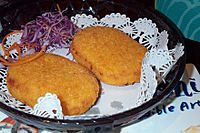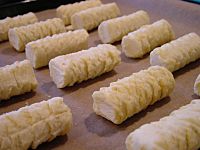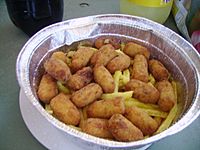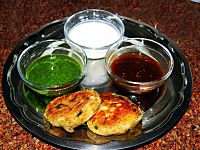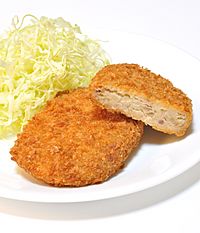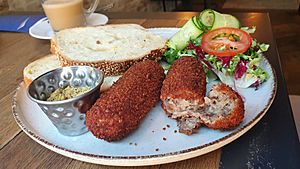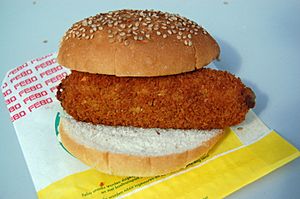Croquette facts for kids

Cylindrical croquettes
|
|
| Main ingredients | Ground meat, shellfish, fish, ham, cheese, mashed potatoes, vegetables, béchamel or brown sauce |
|---|---|
A croquette (say "kroh-KET") is a yummy fried snack or side dish. It's usually made from a thick mix of ingredients, like mashed potatoes or a creamy sauce called béchamel. This mix is then combined with tasty fillings.
Common fillings include finely chopped meat, seafood, cheese, rice, or different vegetables. Sometimes, herbs and spices are added for extra flavor. Once the mix is ready, it's shaped into a ball, disk, or cylinder. Then, it's covered in breadcrumbs and deep-fried until it's golden and crispy! Croquettes are enjoyed all over the world as a quick snack or part of a meal.
Contents
What's in a Name?
The word croquette comes from French. It's based on the French word croquer, which means 'to crunch'. This makes sense because croquettes are known for their crispy outside! In the 1700s, people often spelled it croquet.
Where Did Croquettes Come From?
Croquettes have been around for a long time! A recipe from the 1600s describes croquets made with meat, truffles, and cheese. These were mixed with egg, breaded, and then fried. They could be big, like an egg, or small, like a walnut.
In the 1700s, an English dictionary even mentioned them. The croquettes we know today, with a thick creamy base, were first written about in an English cookbook in 1822 by a French chef named Louis Eustache Ude.
Croquettes Around the World
Croquettes are super popular in many countries, especially in Asia and Europe. Each place has its own special way of making them!
Asia
-
Two Dutch kroketten, one cut open to show the beef-ragout filling; Chiang Mai, Thailand
India
In Northern India, a potato-filled croquette called aloo tikki is very popular. It's often served with a stew and eaten as a snack. You can find them sold by street vendors. In West Bengal, a similar dish is called "vegetable chop." Sometimes, meat croquettes called kababs are made with minced mutton. In Goa and Kerala, lightly spiced beef croquettes are a favorite snack.
Sri Lanka
Sri Lanka has two main types of croquettes. "Rolls" are cylindrical and often filled with fish, potatoes, and spices. They are a common bakery item. "Cutlets" are round and usually made for special events.
China
In China, croquettes are called kělè bǐng. They are often made Japanese-style, with mashed potatoes and corn, and sometimes a little meat.
Indonesia
In Indonesia, the kroket (from Dutch) is a very popular snack. It's made from mashed potato filled with minced chicken or a creamy ragout. This dish was brought to Indonesia during Dutch colonial rule.
Japan
In Japan, a croquette-like food called korokke is super popular. You can find it everywhere, from supermarkets to butcher shops. It's usually patty-shaped and made mostly of potatoes with some vegetables like onions and carrots, and a small amount of meat. It's often eaten with a special sauce called tonkatsu sauce.
There's also a "cream korokke" which is cylindrical. It has seafood or chicken in a white sauce that melts when it's hot. If a Japanese croquette is made mostly of meat, it's called menchi katsu, not korokke.
South Korea
In South Korea, croquettes are called goroke or keuroket. They are sold in many bread shops. The most common type is a deep-fried roll filled with japchae ingredients (a Korean noodle dish) or chicken curry and mashed potato. Sometimes, goroke are filled with kimchi or bulgogi (Korean BBQ meat).
Europe
Belgium
In Belgium, Kroketten (or croquettes) can be a side dish or a main meal. They are usually savory and filled with mashed potatoes. The most popular Belgian croquettes have a thick creamy filling mixed with tiny grey shrimps or cheese. When served as a main dish, they often come with a salad, fried parsley, and frites.
France
The creamy, ragout-filled croquette was seen as a fancy French dish. The first recipe was written in 1691 by the chef of King Louis XIV. It used special ingredients like truffles and cream cheese. Later, in the 1800s, croquettes became a clever way to use up leftover cooked meat.
Germany, Austria, and Switzerland
In these countries, plain potato croquettes are a common side dish in restaurants. You can also buy them frozen in stores. They are simply called Kroketten.
Hungary
In Hungary, Krokett is a small, cylindrical croquette. It's made from potatoes, eggs, flour, and butter, seasoned with nutmeg and salt, then deep-fried. You can order it in most restaurants as a side dish or buy it frozen. If it's made with cottage cheese, it's called túrókrokett.
Italy
In Italy, crocchette are mostly made with mashed potatoes or vegetables like eggplant. Famous Italian croquettes include rice arancini from Sicily and supplì from Rome. In other parts of Italy, croquettes might be filled with chicken or rice and cheese.
Ireland
Plain potato croquettes are easy to find frozen or in the fridge section of most supermarkets in Ireland. Many people also make them at home, often adding chopped onion.
The Netherlands
After World War II, croquettes became super popular in the Netherlands as a fast food. They are made with a meat ragout (a thick, rich sauce) covered in breadcrumbs and then deep-fried. People in the Netherlands eat about 350 million kroketten every year! It's the second most popular snack after the frikandel.
There are many different kinds of Dutch croquettes. You can find rundvleeskroket (with beef) and kalfsvleeskroket (with veal). Other popular types include satékroket (with peanut satay sauce) and goulashkroket. A smaller, round version called the bitterbal is often served with mustard as a snack in bars.
A Broodje kroket is a croquette served on a bread roll. You can buy these in restaurants, snack shops, and from street vendors. They are so popular that even McDonald's sells their own version called the "McKroket."
Poland
In Poland, croquettes are usually made from a thin, rolled pancake, like a crepe. This pancake is stuffed with meat, mushrooms, cabbage, or sauerkraut. The croquette is then lightly pan-fried before serving. Sometimes, they are also covered in breadcrumbs and fried, then served with a clear soup like barszcz (a type of borscht).
Portugal
In Portugal, croquetes are cylindrical, breaded, and deep-fried. They are usually made with a white sauce and beef, sometimes mixed with pork or chouriço (a type of sausage). They might also have black pepper or piri-piri for extra flavor. While other fried foods exist, the name "croquete" usually means the beef version.
Russia
In Russia, a common dish similar to a croquette is the minced cutlet (kotleta rublennaya). It's made from minced meat (beef, pork, chicken, or fish) mixed with bread, eggs, onions, salt, and spices. It's shaped into a patty and pan-fried. The bread makes it softer and cheaper to make. The Pozharsky cutlet is a famous type of cutlet with butter mixed into the minced meat.
Spain
Traditional croquetas in Spain are made with a thick béchamel sauce. They are one of the most common tapas dishes (small plates of food). Popular fillings include jamón (cured ham), chicken, or saltcod. Many restaurants also offer new and exciting croquettes with fillings like apple, wild mushrooms, different cheeses, or even cuttlefish ink! Places that specialize in croquetas are called Croqueterías.
United Kingdom
In the United Kingdom, you can find potato-filled croquettes frozen or in the refrigerated section of most supermarkets.
Caribbean
Puerto Rico
In Puerto Rico, croquettes are often made from ham, codfish, or chicken. They are usually dipped in a sauce called "mayo-ketchup." You can buy frozen croquettes in supermarkets. Some unique versions are made with taro, cornmeal (called sorullos), breadfruit, yams, or cassava instead of wheat flour or potato.
Cuba
Cuban croquettes are very similar to Puerto Rican ones, usually made with ham or chicken. There are also common versions with cheese and potato, and sometimes fish.
Dominican Republic
Dominican croquettes are almost the same as Cuban ones, often made with ham or chicken. They also have cheese and potato versions, beef, and sometimes fish.
Aruba
In Aruba, croquettes are commonly made with mashed potato, ground beef, shellfish, and fish. They are eaten as an early breakfast or as snacks throughout the day. They are considered an important part of the island's traditional foods.
North America
Mexico
In Mexico, croquettes are usually made with tuna or chicken and potatoes. In southern Mexico, a special kind is made with fresh cheese, plantain, and black beans.
United States
On the east coast of the United States, "Boardwalk" fish cakes and crab cakes are very similar to croquettes. They are made from chopped fish or crab meat mixed into a buttery dough, then breaded and deep-fried.
A deviled crab (croqueta de jaiba) is a special blue crab croquette from Tampa, Florida. The crab meat is seasoned with a unique Cuban-style sauce, breaded with stale Cuban bread crumbs, shaped like an oval, and fried. It's designed to be eaten with one hand. It started in the 1920s and is still very popular there.
Other types of crab and fish croquettes are made across the southern U.S., especially in coastal states like Louisiana where seafood is common. These have different seasonings and shapes.
In New England, a traditional croquette uses ham, usually maple-cured, mixed with mashed potato. These are dipped in breadcrumbs and pan-fried in butter. They are most common during the Thanksgiving and Christmas holidays as a way to use up leftover ham.
Another popular croquette dish in the American South is salmon croquettes. Canned fish, usually salmon or mackerel (or even tuna), is mashed and mixed with a binder and seasonings like pepper, salt, onions, garlic, or lemon juice. The mix is shaped into patties and pan- or deep-fried.
South America
Brazil
In Brazil, croquettes, mainly made from beef, are a common snack. The coxinha is a very popular chicken-based croquette.
Ecuador
From Riobamba, Ecuador, llapingachos are potato cakes with a cheese filling. They are fried in oil and served with a peanut sauce.
Uruguay
In Uruguay, croquettes are called "croquetas." The most popular fillings are mashed potatoes, ham and mozzarella cheese, and rice. Sometimes, the rice ones have herbs and small ham cubes. They are usually cylindrical and medium-sized, but larger, round ones can also be found, especially with rice filling. They are deep-fried.
Croquettes are very common in Uruguay. You can buy them in almost every bakery, supermarket, or food shop. Many people also cook them at home as a side dish or even a main meal. In modern restaurants, fancier croquettes might come with a special dipping sauce and are ordered as appetizers.
Colombia
In Colombia, croquettes are commonly called "papa rellena," which means "stuffed potato." They are made from roughly mashed potato, seasoned shredded or ground beef, and an egg to hold it all together. This mix is then lightly battered and deep-fried. They are served in bars and casual restaurants, and often at home for parties. They are usually served with a side of chili sauce.
Images for kids
-
Two Dutch kroketten, one cut open to show the beef-ragout filling; Chiang Mai, Thailand
See also
 In Spanish: Croqueta para niños
In Spanish: Croqueta para niños


